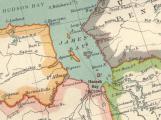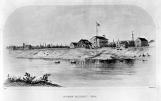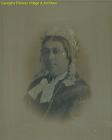1
James Anderson's Interaction with First Nation Peoples
Hannah Bay Massacre
2
During his first winter with the Hudson's Bay Company, James Anderson helped to apprehend a group of First Nations people who had murdered the occupants of the Hannah Bay post.In January of 1832, a small group of First Nations people arrived at Hannah Bay, requested and were given provisions. Two days later, they murdered the occupants of the post, plundered it, and left. Survivors fled to Moose Fort, where a search party was organized. The motivation for this incident is unknown, but it may have been due to inadequate treatment by the employees at Hannah Bay. In his report, James Anderson stated that "[f]rom the women it was afterwards ascertained that the Indians intended to have cut off the different small posts in the interior of Rupert's River District - then Rupert's House and lastly, Moose Factory." However, no other such incident ever occurred in the James Bay region.
3
The small post at Hannah Bay, at the south of James Bay, was the site of the massacre in 1832Circa 1900 (map)
 Credits:
Credits:Dominion of Canada map
http://www.bouletfermat.com/backgrounds/canada_circa_1900/Specials/james_bay_map_c1900_300dpi_800x600.jpg
4
The survivors of the Hannah Bay Massacre fled to the Hudson's Bay Company Post at Moose Factory1854
 Credits:
Credits:http://www.geocities.com/chapleaucree/moosefactory001.jpg
5
James Anderson's Interaction with First Nation Peoples
James Anderson's Marriage
6
Margaret Mackenzie Anderson, wife of James Anderson1868-1888
Georgina Pioneer Village & Archives
 Credits:
Credits:Georgina Pioneer Village & Archives
7
In 1839, on a trip to Sault Ste. Marie, James Anderson married Margaret Mackenzie. She was the daughter of Captain Roderick Mackenzie of Red River, who was a Chief Factor for the Hudson's Bay Company in the English River district. Margaret's mother was a First Nations woman named Angelique.8
Believed to be Margaret Mackenzie Anderson19th Century
Georgina Pioneer Village & Archives
 Credits:
Credits:Georgina Pioneer Village & Archives
9
Roderick Mackenzie18 February 1970
Sutton, Ontario, Canada
 Credits:
Credits:Alexander Bourchier Anderson, 1884-1971
Georgina Pioneer Village & Archives
10
James Anderson's Interaction with First Nation Peoples
James Anderson's Opinion on Native Sons
11
When James Anderson began his career with the Hudson's Bay Company in 1831, European views on race were based on notions derived from colonialism, capitalism, and developments in the sciences. Race was viewed in terms of a hierarchy, with so-called civilized Europeans placed at the apex, and "un-civilized" non-Europeans located at the bottom. This concept influenced how HBC workers of European ancestry interacted with First Nation people, and determined the positions that they were allowed to take within the Company.Children of European traders and First Nations women were known as "native sons." Before 1820, native sons could embrace both cultures and use the skills from each in the fur trade. However, after the Hudson's Bay Company amalgamated with the North West Company, a more rigid hierarchy was imposed, class and race consciousness became issues, and native sons were kept from advancing in the ranks of the Company.
Beginning in the 1790s, European fathers felt the need to separate their children from the First Nations culture and instead instil in them "civilized" European habits. The London Committee of the Hudson's Bay Company went so far as to send school supplies and teachers for native sons.
HBC Governor George Simpson was notorious for impeding the advancement of native sons: His description of the native sons who were traders, clerks, and interpreters progressed from "tolerable" to "tolerable for a halfbreed"; he suggested that their salaries be reduced, and repeatedly stated that they had no possibility of advancement. To make sure that they could not be promoted, he created the position of postmaster, which ranked between interpreter and clerk. In describing the position, he stated that those who held it had "no prospect of further advancement, nor is it intended that they shall be removed from this Class except in very particular cases of good conduct coupled with Valuable Services."
Both Chief Factor Donald Ross, and James Anderson, who was at the time Chief Trader, protested the new position. Anderson insisted that the position be abolished, saying that, "banishing all considerations of origin that education, ability and character should be the qualifications required for granting Apprentice Clerkships in the service." However, despite this opposition, the rank of postmaster persisted until 1875.
12
Chief Factor Donald Ross protested the position of postmaster1846
 Credits:
Credits:from an oil painting by Paul Kane
http://www.mhs.mb.ca/docs/mb_history/44/embattlednotions3.jpg
13
James Anderson's Interaction with First Nation Peoples
Census 1858